Throughout history, the migration of people and the exchange of food culture across different regions have played a significant role in the fusion of culinary traditions. This phenomenon has been heavily influenced by geography and has contributed to the origin and evolution of food culture.
The Historical Migration of People and Culinary Traditions
Human migration has had a profound impact on the exchange and fusion of culinary traditions. As people moved from one region to another, they carried with them their food preferences, cooking techniques, and traditional recipes. Over time, this led to a blending of culinary practices, resulting in the emergence of new, hybrid food cultures.
Influence of Geography on Food Culture
Geography has played a crucial role in shaping food culture. The availability of natural resources, climate, and topography have all contributed to the development of specific culinary traditions in different regions. For example, coastal areas often have a strong emphasis on seafood in their cuisine, while inland regions may rely more on grains and livestock. The geographical diversity has fueled the exchange of food culture as people adapted to their new environments, incorporating local ingredients and cooking methods into their traditional dishes.
Exchange of Food Culture across Different Regions
The exchange of food culture across different regions has been facilitated by trade, conquests, colonization, and cultural diffusion. Through these interactions, various ingredients, spices, and cooking techniques were shared and integrated into local cuisines. This cross-pollination of food culture has resulted in culinary fusion, where new and innovative dishes have emerged, blending the flavors and traditions of diverse populations.
The Origin and Evolution of Food Culture
The origin and evolution of food culture can be traced back to the ancient migrations of early human societies. As people spread across the globe, they encountered new ingredients and culinary practices, leading to the development of distinct regional food cultures. Over time, these food cultures evolved through the exchange of ideas and the incorporation of foreign influences, resulting in the rich tapestry of culinary traditions we see today.
Fusion of Culinary Traditions
The fusion of culinary traditions is evident in the diversity of dishes around the world. For example, the fusion of African, European, and Indigenous American culinary traditions gave rise to the vibrant flavors of Latin American cuisine. Similarly, the fusion of Asian and European food cultures led to the creation of unique fusion dishes such as Nikkei cuisine, blending Japanese and Peruvian culinary traditions.
Conclusion
The historical migration of people and the exchange of food culture across different regions have been instrumental in the fusion of culinary traditions. Geography has influenced the development of food culture, and through the exchange of ideas and ingredients, new culinary traditions have emerged, reflecting the dynamic and interconnected nature of human societies.


